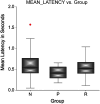It's About Time: Parent-Child Turn-Taking in Early Stuttering
- PMID: 39689055
- PMCID: PMC11745306
- DOI: 10.1044/2024_AJSLP-24-00155
It's About Time: Parent-Child Turn-Taking in Early Stuttering
Abstract
Purpose: Most common treatments for stuttering offer advice that parents modify temporal features of conversational interaction to assist children who stutter (CWS). Advice includes but is not limited to slowing of adult speech, increasing turn-taking/response-time latencies (RTLs), and reducing interruptions. We looked specifically at RTL and parental speech rate in a longitudinal data set that included baseline behaviors.
Method: We used data from baseline recordings (CWNS = 13 CWS-persistent, 28 CWS-recovered, 21 children who did not stutter) of the Illinois International Stuttering Research Project at FluencyBank, using CLAN software with audio linkage to Praat.
Results: Group differences in speech rate and RTL at baseline were nonsignificant; parents of CWS-persistent spoke most slowly pre-advisement. No relationships between speech rate or RTL and child fluency were detected.
Conclusions: This is a retrospective, observational study, and caution must be used in interpreting our findings. However, current results do not add evidentiary support for common advice to adjust temporal parameters of their interactions made to parents of CWS, in terms of therapeutic outcome or concurrent fluency. We are analyzing subsequent samples, after advisement, to determine potential benefits of such guidance not evident in this analysis. Suggestions for future research and implications for clinical focus and practice are offered.
Figures





References
-
- Berko Gleason, J. (1975). Fathers' speech and other strangers: Men's speech to young children. In Dato D. P. (Ed.), Developmental psycholinguistics: Theory and applications (pp. 289–297). Georgetown University School of Languages and Linguistics.
-
- Bernstein Ratner, N. (1993). Parents, children, and stuttering. Seminars in Speech and Language, 14(3), 238–250. 10.1055/s-2008-1064174 - DOI
Publication types
MeSH terms
LinkOut - more resources
Full Text Sources
Medical

